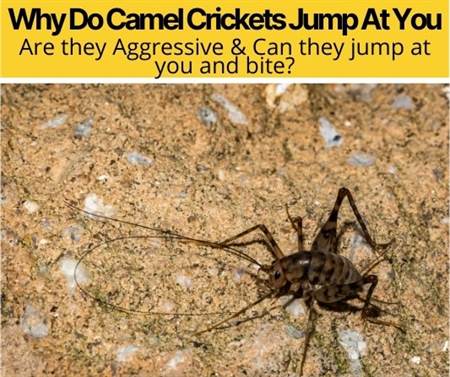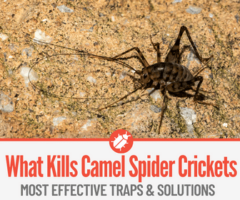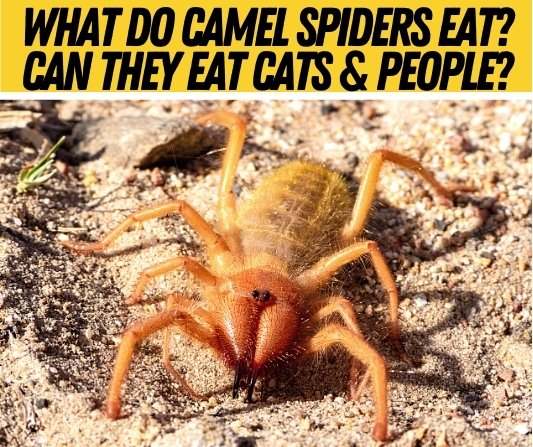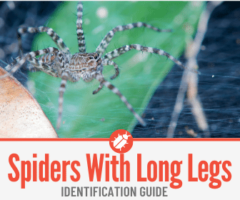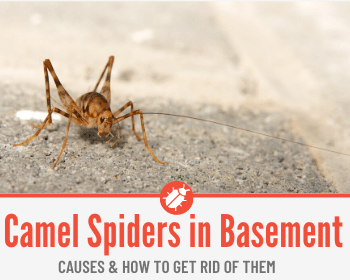 Camel Spider Crickets usually appear in the basement during summer and fall, causing huge inconvenience to the homeowners.
Camel Spider Crickets usually appear in the basement during summer and fall, causing huge inconvenience to the homeowners.
They are known to eat and chew on almost anything that they can find in the basement.
In this Guide you will learn why they like to live in basements & give actionable recommendations on how to get rid of them from basement.
Huge Jumping Crickets That looks like Spiders in Basement – What are They?
Camel Spiders are known by a few names, such as spider crickets, cave crickets or even Sprickets. Scientifically, they belong to the Rhaphidophoridae family
One of the reasons why some call them Cave Crickets is because they like to hide in dark and moist places -such as caves and in basements where they can find food and shelter.
Even though they are called spiders Crickets, they are not actually spiders, as they have only got six legs instead of eight.
They belong to the insect order Orthoptera, which makes them related to other crickets, grasshoppers, and locusts.
Unlike Regular Crickets Cave Crickets are not able to chirp, and they have no wings nor inner ears compared to Ordinary Crickets.
Camel Crickets are harmless and they are not poisonous either (Apart from chewing up contents of your basement). If you scare a Camel Spider, they may however Jump at you to try to scare you in leaving them alone.
Continue Reading: Do Camel Spider Crickets Bite
Camel Spider Cricket Infestation in Basement
As one of their many Names Suggests, Camel Spiders like to live in caves, as they prefer the damp and humid environment.
Camel Crickets like to live in rotten logs, hollow trees, and in damp leaves in nature, although in the suburban areas Cave Crickets find drains, sewers, wells, firewood stacks, and basements attractive as well.
A Basement in your home can be just as good of a cave to them!
They are attracted to these areas as the damp & moist environment offers them food and shelter.
The Camel Spider feeds on fungi, which often appear on the damp basement walls.
Why do I have camel crickets in my basement?
Camel Crickets enter human’s homes as they are looking for food and shelter.
They prefer lightless and moist environments, so the houses’ basements are a perfect choice for them.
The cricket spiders’ main source of food is fungi, which usually grows on damp walls, and is particularly common on basements’ walls.
The Cave Spiders have strong mandibles, which allow them to chew household items, including fabric, carpets, wood, and cardboards, and camel crickets will often eat dust, plants, even pet food!
Read more: What do Camel Spiders Eat
An interesting fact is that sometimes the camel spiders eat cat litter as well, and there have been occasions when they even chewed each other or their own leg!
In summary, there are four reasons that the camel spider can occur in the basement:
Living conditions & shelter:
- In nature, the camel spider often lives in logs and under wet leaves, as the cave spider likes dark & damp environments.
- The basement with humid and dark conditions is just a perfect choice for them during summer and fall, as they can seek shelter from the long summer daylight hours and the heat.
Food:
- The cave spider’s diet is varied; they eat fungi, which often grows on wet basement walls.
- They just as easily eat household items such as fabric, carpets, wood, cupboards, dust, plants, pet food or even cat litter! These items are often found in the basement.
Cluttered places:
- The camel spider likes cluttered places, as it is more likely for them to find dust and even more household items.
Reproduction:
- The camel spider needs moist places to lay its eggs, and a damp basement is a perfect option for this.
- The cave cricket lays between 50 to 200 eggs, where the hatching time is three to four weeks.
- As you can see, one spider can quickly become a lot more, if the cave spider left unnoticed for a longer period!
How do Camel Crickets get in the basement?
Camel Spiders find basements attractive as they offer similar living conditions to the humidity that they can find in nature.
Moisture is important for their reproduction too and basements offer food for them as well.
Cave Crickets can get into the basement if the house has got no proper waterproofing or is not properly sealed.
The cave crickets can take advantage of these houses and get through small gaps into the basement.
What time of Year Do Camel Crickets enter your basement?
Camel crickets usually enter the basement during the summer and autumn.
The weather is warm during the summer, and they are looking for somewhere to hide.
In addition to this, the daylight hours are longer, and the camel spiders usually hunt at night when it is dark.
Occupying the basement temporarily is a perfect living condition for the cave cricket, as they can find everything that they need, including conditions for their reproduction system!
How to Get Rid of Camel Crickets in Basement?
There are a few ways and tricks to get rid of camel crickets from your home.
Some of them are quite creative ways, involving smaller – or bigger – DIY projects, as well as some ordinary solutions depending on your budget and the size of the infestation.
- Sticky traps:
- You can use traps made of duct tape by placing a piece of pet food into them, which is attractive for the hungry cave spider.
- The cave crickets will eventually get stuck to the tape when placed in basement.
- Soapy water:
- Camel spiders like water, by placing little containers filled with soapy water around the basement is a perfect trap for them as well.
- Once they crawl into the water, they will be trapped there.
- Sealing & waterproofing:
- Sealing and waterproofing your house & basement is the best method of prevention for the future to avoid a camel spider infestation.
- Dehumidifying:
- Buying a dehumidifier will remove the humidity of the air of the basement, removing an element that fungi need to grow on the walls of the basement and a source of nutrition of the cave cricket.
- Electronic rat trap:
- Buying from Amazon or Ebay, an electronic rat trap works as the insects enter the trap and a high voltage current is sent through the body of the insects, causing an electric shock, and killing them quickly.
- Re-organising and decluttering the basement:
- The cave cricket likes to hide and likes crowded places, where it is possible to find food such as dust and household objects.
- A dark, messy, dusty, and crowded basement is a perfect spot for the camel spider. Re-organising and decluttering will make the basement less attractive for them.
- Vacuuming and regular cleaning to remove dust and dirt, which attract camel spiders and a food supply for them too.
- Call an expert:
- If the situation is very bad and you are not able to solve the infestation in basement, calling an expert is the best solution.
- Buy a Siamese cat:
- An interesting fact that the Siamese breed is a heartless predator of the cave crickets.
Preventing Camel Spider Crickets from Entering your basement
The best way to prevent a Camel Spider infestation in basement is to remove the factors that attract the insects to enter the basement.
- The first and most important step is to make the house properly sealed and waterproof. It is important to have a higher focus on the basement which is usually dark and is the place where the cave spider is the most likely to occur, as it finds this place the most attractive.
- Second, keep the basement well-lit and clutter free, as the cave spider prefers dark places and does not like well-lit places.
- Third, using dehumidifiers to remove dampness and preventing the growth of fungi on the walls that the camel spider usually feeds on.
- Fourth, regular cleaning and vacuuming to keep the basement clean and dust free, removing dust as a source of food for the camel spider.
- Fifth, using shelving to keep items and objects off the floor and using plastic storage boxes with a lid instead of cardboard to store clothing and pet food. Cardboard boxes attract cave spiders as they chew on them.
What do Dead camel Spider crickets in the basement mean?
Be careful and prepared about an infestation as there might be more camel spiders hiding in the basement.
A deep-clean and a clear out is well recommended.
On the other hand, alive camel spiders are more likely to consume the cavity of their dead fellow.

